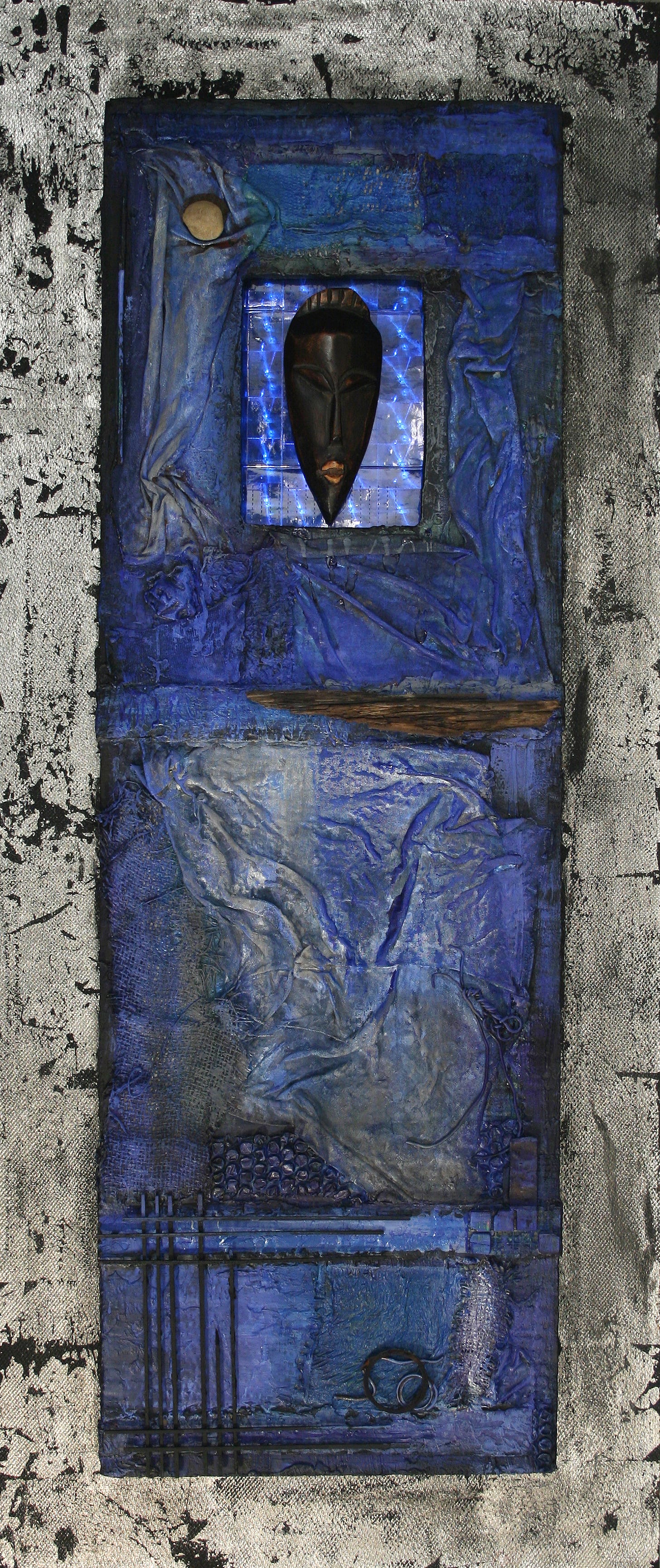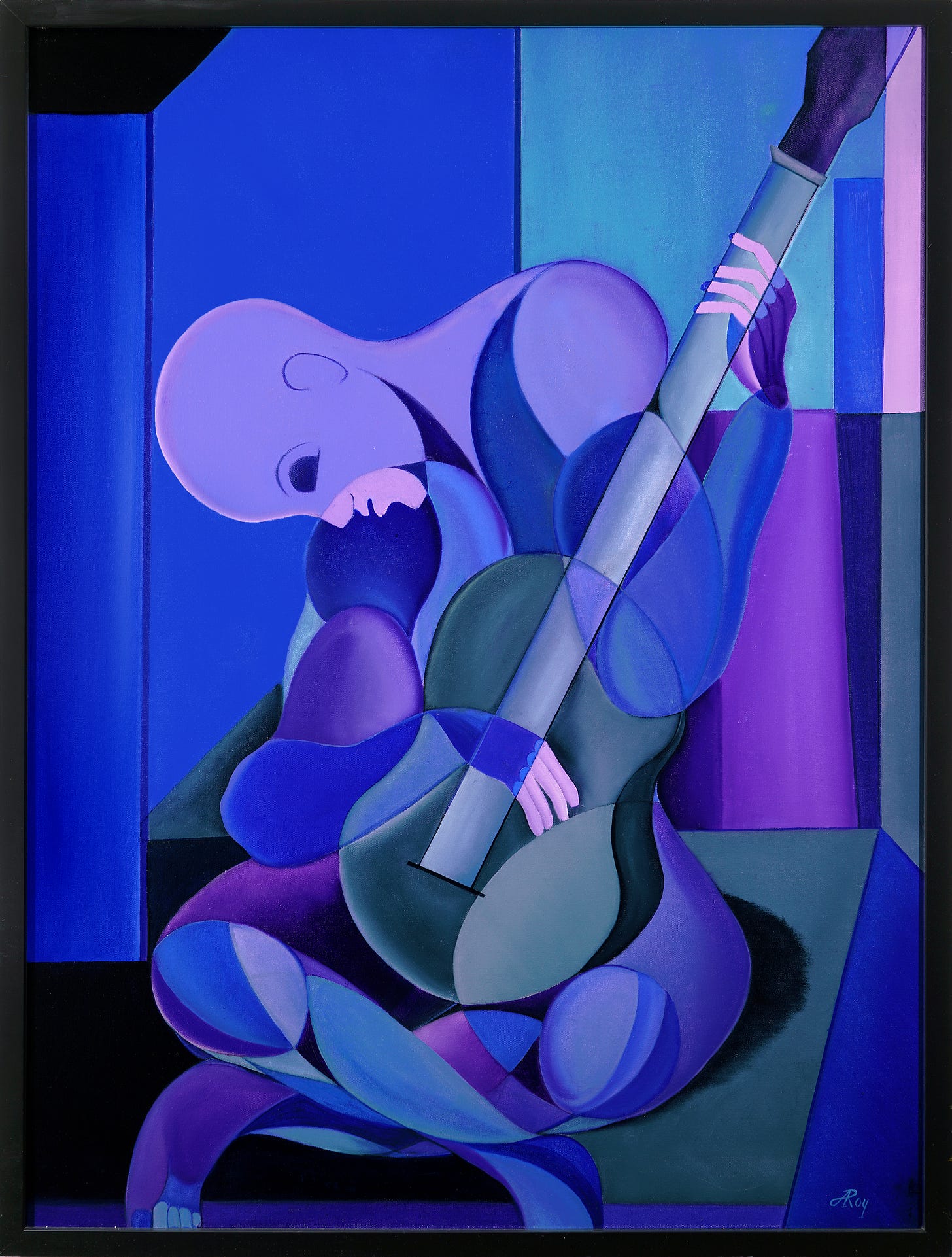The diverse works of Houston artist Alvin Roy show the evolution of different ideas and expressions cumulatively birthed from a fascination with geometry. The use of this word suggests impenetrable symbols and theorems, yet if we think of them as a threshold rather than an impasse, we can begin to appreciate them as Roy has. His interest in the structured element used in tangent with other elements and details, creating inspired narratives that appear oblique and iconic at the outset, have led him through at least three major bodies of work, which altogether construct his Southern Patchwork. Everywhere in Roy’s work there are structures to be found. In some works they are imprinted upon the surface, while in others they are suggested by icons that resemble architectural or symbolic motifs from an ancient structure suggestively excavated, melded with musical instruments or scored music into illustrative elegies, and floating effervescently amid thatched forms and behind bars that shine like jewels, as if they were the very spirits emerging during a ritual celebration, harbingers of an essential ethos long forgotten. But what’s close to the surface in Roy’s work is only half of the picture. There is also a layering of meaning that goes well beyond the obvious. Think of geometry as a structural manifestation of transcendence, which holds together all the forms while at the same time providing them with a backbone from which to pulse forth in all their expression. The fact that it seems patently invisible makes it more essential to the viewing experience.
Roy’s work allows certain ancestral effects that flow through him and land upon the canvas. Together, amid specific oeuvres and altogether between all his themes, Roy can animate these impulses in a way that addresses all their accumulated portent, while at the same time creating forms that are both beautiful and mysterious. A work such “Guitano” (2010) depicts a solitary musician lost in the moment, consumed by the sorrowful profundity of an engagement with deep emotional energies. This intensity provides knowledge of the human spirit in situations of great distress or emotional danger. The mood of the anonymous portrait is matched by Roy’s implementation of an innate geometric structure, albeit one that bends to the energy of the moment. We are made to perceive the relationship between a charismatic geometry, and the feeling that alters its use—body versus mind, or brain versus heart. The celebration of strong emotions through music, even one without words, creates a tension that Roy plays upon again in his Cubist reading of the human body in repose, creating symmetry through suffering as he puts us in sync with the music.
In other Music series works, it’s not sadness that suffuses the geometry of expression, but a dimensional tapestry of forms that lends the viewer both geometry and its opposite, which is chaos. A strong example of this series is “The Dream in Her Head Blowing in 4/4 Time” (2022) in which Roy presents a figure in side-profile, the traditional perspective by which women were portrayed in art up through the nineteenth century, the “side-saddle” of artistic perspective; the woman is presented as passive, as a muse, but without agency. In this case, her form and her face serve to give presence to what would otherwise be a very structured void attached to no one or no place. The woman’s portrayal lends narrative to the image while simultaneously allowing us to imagine it as an interior narrative flowing out of her mind, like the demons in Francisco Goya’s masterpiece “The Sleep of Reason Produces Monsters” (1799). Her presence alone, depicted at a grander scale than all the other elements of the picture—the neck of a guitar, an upright trumpet, sheet music notations--infers her importance as a presence. The grid or lattice through which the objects are seen is the structure of her mind projected for the benefit of the viewer. The profusion with which they are presented is the counterpoint of her thought as it accrues intensely.
The presence of a structural environment, of an innate measurement providing beauty through proportion, appears in a different spirit in both the Talking Heads and the Urban Excavations series. These images were generated as a consequence of Roy’s extensive travels through the 1970’s, first in Europe, where he came into contact with artists who had apprenticed under Pablo Picasso and Salvador Dali, and having digested the aesthetic and philosophical qualities of both these important Modern artists, he arrived first to Nigeria and then to Egypt with something of a loaded consciousness, as is evidenced by the substantial results that occurred in his work, and which continue to inspire him today. It’s important to consider these two series in tandem because they followed so closely upon one another, and in each case, there was a prevalent use of direct symbolic emphasis to complement Roy’s geometric thought structures. These two bodies of work are striking in their idiosyncratic specificity, yet both also share elements that play off on another.
A good example of the aesthetic and deeply formal proportions on hand in the Talking Heads series can be glimpsed in “Ancestral Moans” (2019) in which Roy uses a structural and deeply oblique use of diffuse color and visual depth to aesthetically manifest ancestral spirits as they are said to inhabit certain places on certain dates, corresponding to their births or death when they were alive decades or centuries before. The grid of bars glows as if filled with a divine light, speaking essential truths to the shamans and those otherwise initiated into the ceremonial proprieties that allow native countrymen to communicate with their revered and deified dead. The painting is not merely eerie and evocative but is brilliantly constructed to force the viewer to peer deeply into its depths, beyond the pale of mere superficial reality. This painting overtly references the obscure depth of Cubist agendas, in which the real is used as a means of subverting aesthetic space, filling it with linear and chromogenic tension.
Different by degrees and special in its own way are Roy’s Urban Excavation works. These are attached to his travels in Egypt, where he likewise connected to a ritual-laden religion in which both ancestors and figures out of historical royalty were not only ordained in innate authority but connected to a historically recognized religious order. The belief that everyday people are related to divine or mythical figures from the distant past is a concept shared across many cultures. In acts as means of enlivening the importance of contemporary society, in which commonplace qualities both overwhelm and debase degrees of meaning. Roy participates in this genre of celebration by commingling his own interest in history and myth with an interest in creating artifacts, like “Mimic” which recreates the celestial architecture of an Egyptian temple, or “Blue Aphrodite” (2023) in which the presence of the divine is posited by a mask which is then surrounded by architectural details reminiscent of a pagan grotto, in which nameless ceremonies would have been held to pay respect to the gods.

Both series make a concerted effort to summon spirits while simultaneously manifesting divine form through geometric interest. It is important to note, in closing, that Roy’s role as the creator of the series of works described here, is due to a historical and cultural background that inspired each series and by extension, names them each as single patch in an the “Southern Patchwork” which plays out all through this exhibition and likewise through his entire output as an artist, from the earliest examples, to now, to ones yet realized. Roy’s family and its roots in diverse historical and cultural contexts—African American, American Indian, and of the American South culture—have made him the man and the artist he is today, as have direct relationships to grandparents and great-grandparents in his youthful education. These elements drove him to explore both Nigerian and Egyptian cultures, to connect with the importance of ancestral veneration, and to form the basis for a formal aesthetic connecting to geometry, as a further method of revealing the innate structures of a moral universe. The language of order that Alvin Roy has established, and consistently found new ways to expand as a means of enlightened creative discourse, creates a patchwork of inspiration for us all.






